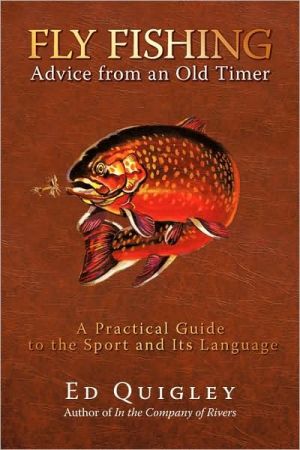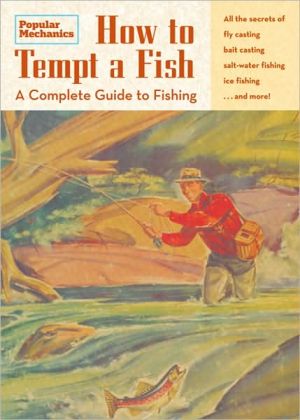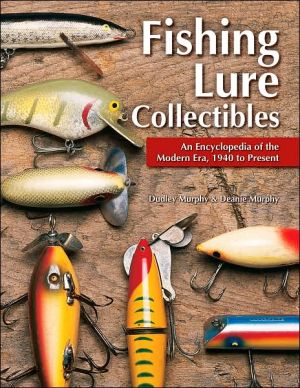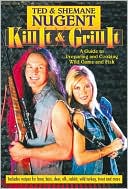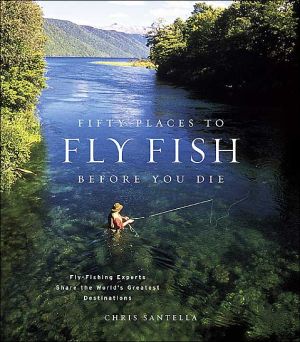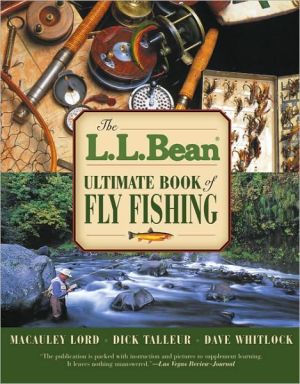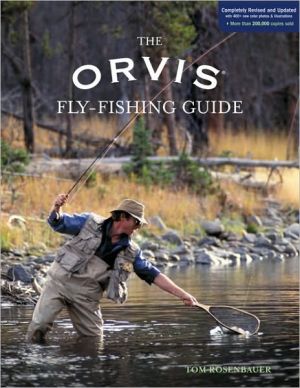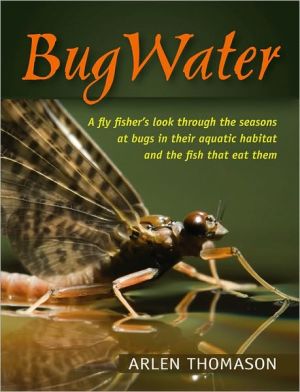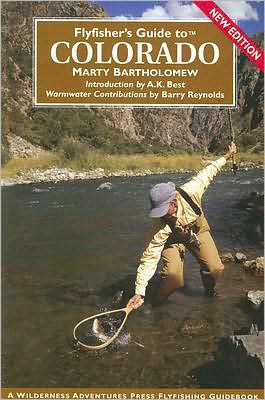Fly Fishing Advice From An Old Timer
Gain decades of fly fishing know-how from this handy volume!\ Whether you're new to fly fishing or just want to add some new "secrets" to your own bag of tricks, Ed Quigley's Fly Fishing Advice from an Old Timer has the information that you've been searching for in one handy volume. This guide is packed with easy-to-follow explanations of the basics plus ingenious tips and entertaining anecdotes culled from Quigley's years of experience fly fishing streams from Labrador to Costa Rica.\ When...
Search in google:
Gain decades of fly fishing know-how from this handy volume! Whether you're new to fly fishing or just want to add some new "secrets" to your own bag of tricks, Ed Quigley's Fly Fishing Advice from an Old Timer has the information that you've been searching for in one handy volume. This guide is packed with easy-to-follow explanations of the basics plus ingenious tips and entertaining anecdotes culled from Quigley's years of experience fly fishing streams from Labrador to Costa Rica. When should you use emergers, caddis flies, midges, cripples ... and how can you create them literally "on the fly" right there in the stream? How do you choose the best rod, reel, lines, waders and leaders? What's the real secret to playing a fish? What's up with winter fishing? Quigley gives you all the answers along with advice on where to find more information on each topic: web sites, articles, DVDs and books. He also includes a "must read" list of fly fishing books with comments on what he found most useful in each. Fly Fishing Advice from an Old Timer has it all!
Fly Fishing Advice from an Old Timer\ A Practical Guide to the Sport and Its Language \ \ By Ed Quigley \ iUniverse, Inc.\ Copyright © 2009 Ed Quigley\ All right reserved.\ ISBN: 978-1-4401-6551-1 \ \ \ Chapter One\ Artificial \ An adjective derived from a French word meaning made with art or artifice. Fly fishermen use it as both adjective (an artificial fly) and as a noun (The artificial I used just didn't work.) In short, it is a word used to designate a handcrafted fly whether it is made of synthetic fibers, tinsel or plastic, or natural materials such as feathers, wool, hair and fur.\ For a discussion of the theory behind the creation and design of artificial flies and speculation on what are the primary characteristics of an effective artificial fly, see also Imitations.\ Backing\ A relatively thin, lightweight level line made of nylon or Dacron either white or colored, one end of which is tied around the arbor of the reel with a spool knot and the other end to the back of the fly line with a nail knot. It has two purposes; first to fill up space on the reel under the fly line, and, second, to give you extra line to play a fish that runs far enough to peel the entire 100+ feet of fly line off the reel. In regular fly fishing the number of yards of backing you need is determined simply by the space you need to fill up the reel. In more extreme situations, forexample in salmon fishing or bone fishing, you'll need 150 yards of backing and for tarpon as much as 200/250 yards.\ Bamboo-(See Cane)\ Barbless hooks\ A barb on a hook is a sharp raised projection, exactly like the one you see on a porcupine quill. It prevents the hook from slipping out once it pierces the trout's jaw. Like all barbs it is a rather nasty thing especially when you get a hook stuck in your ear, hand or any other part of your body. (See Removing a hook)\ The purpose of a barbless hook is to facilitate releasing trout without unduly harming them. In most places where catch and release is encouraged or mandated, their use is required. That's because barbed hooks can sometimes be very difficult to rip out of a trout's mouth. It can get ugly when the hook won't come out easily and you end up crushing the trout with your hand and ripping his jaw apart while trying to get the damn thing out.\ Some hook manufacturers replace the barb with a small bend or hump immediately behind the point of the hook. Others simply eliminate any suggestion of a barb altogether as illustrated below.\ You can turn a barbed hook into a barbless one by using your clippers, forceps or pliers to flatten the barb down flush with the hook. This leaves a bump that helps to hold the hook in place but does not have the sometime ill effects of a true barb.\ Will a barbless hook pull out easier than a barbed hook when you are playing a fish? Of course it will. Will you lose more fish when using barbless hooks? Of course you will. But here's an even more important consideration: barbless hooks and de-barbed hooks are safer for fishermen because they are much easier to remove from human flesh.\ So, my advice is to scrunch down your barbs and/or go barbless. If only for your own sake.\ Bass bug taper\ This is a weight-forward line with a pot belly. You can use this on your bigger rods-7-, 8- and 9-weights-to cut through heavy winds and to throw heavy flies like the Deer-hair Mouse. I use one on my Loomis 8-weight rod up in Labrador for that purpose. It makes it easier to execute a one stroke pick-up-and-lay-down cast. In other words, with this heavier belly, you don't have to struggle to get that Deer-hair Mouse airborne and then false cast it three or four times to feed out line-which, if there's any wind, can be dangerous to you, the guide and the other guy in the boat. In summary, the bass-bug taper enables you to pick up heavier flies more easily, overcome a brisk wind and perform the one-stroke-and-shoot cast much easier.\ Black curse\ A name applied by the Brits to what we call no-see-ums, those unseen black flies that raise whelps and leave behind pin pricks of blood on the exposed flesh of anglers.\ Once while fishing out of Iliamna Lodge on the Gibraltar River in Alaska, I started having trouble tying on flies. My hands just weren't working. I thought the reason was that they had grown stiff in the chilly air. But when I looked at them, I noticed the backs of my hands were swollen. There were tiny pin-head-sized dots of blood all over the backs of my hands. You couldn't even see the tendons. The knuckles were indistinguishable. They were puffed up like a goose-down comforter. My fingers didn't look too swollen but I simply could not move them to tie on a fly. I had to ask the guide to do it for me. "I don't know what the hell's wrong," I said. "The black curse," he said, "those blasted black flies, the no-see-ums. The repellant wears off when your hands get wet. You don't notice at first but they bite the backs of your hands. You need gloves."\ Blank\ Two meanings. First, as in "I drew a blank" where it means to go fishless. To be skunked. Second, as in "I made a rod from a blank," meaning the pieces of graphite, fiberglass or bamboo that have been fashioned into a stick but lack the handle, ferrules and line guides. To save money many crafty fly fishermen will buy "blanks"-you can get top-notch, name-brand blanks like Loomis or Sage-and make up your own rods.\ There are several specialized rod-building catalogs listing all the parts one needs to do the job. This is what custom makers often do. For example, I have a rod which was made for me from a Diamondback blank by a well-known rod maker named Ron Kusse. Making a rod from a blank involves shaping the corks for the handle, fitting the ferrules and wrapping over the feet of the line guides with silk and finishing off the wraps with a coat of varnish. Two of my bamboo rods were "made" by me from blanks bought in the 1960s at Orvis headquarters in Manchester, Vermont.\ Blind casting\ On some, if not most, of the private club waters in the British Isles, an angler may cast only to a rising fish, only with a dry fly and only upstream. In America, of course, we may cast whenever, wherever and with whatever we please. We do not have to wait for a rise and may cast our wet flies, dry flies, nymphs or streamers up, down or across stream helter-skelter. But when you are casting when no rise has been seen or is seen, you are blind casting.\ In fact, most of the time, we are blind casting to spots where hope or experience suggest that trout may lie. In the absence of hatches, which means most of our time on the water, the American fly fisherman is "blind casting." He is attempting to read the water and trying to put his fly into the most likely spots-current creases, bubble lines, the tail of riffles, the center of deep channels, under overhanging limbs, along side fallen logs, in the soft water where two currents meet.\ In my many years' experience fishing at Minipi Lodges in Labrador for giant brook trout; blind casting, especially during the evening rise, was not a tactic of choice. We waited until we saw a rising fish and then pursued it. But I do remember once while returning to the lodge for dinner in the early evening, I asked the guide, as we passed a likely looking spot, "Why don't we try some blind casting?" He replied, "Well, you kin if ya wanna." "I wanna," I said and he slowed the boat.\ To our right was a smooth expanse of water forty feet from shore. Running down its middle was a thin line of bubbles indicating where the current flow was concentrated. I threw a cast aimed at the parade of bubbles. I had on a big, orange Stimulator which alighted upright amid the bubbles. Instantly a trout rose and took it. A four pounder.\ Some Minipi aficionados like Ron Miller of Pittsburgh literally never stops blind casting and he catches his share of fish that way. Perhaps more than his share. But, in Labrador, it is a tactic that I use mainly in the faster flowing water. When I blind cast in the faster water, I generally use a streamer, a Muddler Minnow, a Woolly Bugger, in other words, something bigger than ordinary and most of the time an attractor pattern.\ On the other hand, my fishing pal Richard R. Nixon (some say I have to dig up my friends) is an inveterate blind caster. His fly of choice is almost invariably the Blue-winged Olive. He will cast ceaselessly, dropping his small BWO over and over and over again in the same general area. Like Ron Miller, he does catch fish on some of those blind casts. But never more than his share.\ I suppose the lesson here is that you should always be ready, willing and able to throw a fly to any likely spot. Don't be reluctant to blind cast, especially if you enjoy casting and have the arm for it. As I did that day in Labrador and as Nixon does all the time everywhere; keep casting. And keep moving. As a friend, Ted Ziegler, once said, you are always drilling over oil bearing strata.\ Where to find more:\ As far as casting in general is concerned, I review the fundamentals of casting in this book. But when it comes to learning to cast, pick up a rod instead of a book. Most books make casting sound like some terribly difficult thing. In fact, several casting books read like physics textbooks. Many articles in the magazines also make it sound like science instead of sport. Look. If you want to learn how to hit a tennis ball, go out and play tennis. If you want to learn how to cast a fly, go fishing.\ Blood knot-(See Knots)\ Blue-winged Olive\ This entry should probably be under "Olives." However, I have chosen to use the name of the most prominent member of the so-called "olive" family, the BWO, because it is better known and more widely used in the United States.\ I once thought that the BWO was a single dry fly, a mayfly imitation, dressed, according to Eric Leiser, The Book of Fly Patterns (1987), with olive thread, dark dun hackle fibers for the tail, pale dun hackle tips for wings, medium olive dubbing fur for the body and dark dun hackle. Leiser also gives a recipe for a wet fly version with the same coloration but it is winged with quill sections cut from a Mallard's wing.\ I was, therefore, locked into the thought that this particular fly was truly an olive-bodied dry fly with dun colored hackle, tail and wings. Otherwise why use the word "olive" in its name? It was a revelation to learn that the word "olive" refers, in this case, not to the color of the fly-although its body is often made with various shades of olive dubbing-but to a large number of naturals, the Baetidae, a taxonomic classification of insects that falls within the order Ephemeroptera, which includes all up-winged flies (the mayflies). So olive and olives are collective nouns designating flies of the genus Baëtis.\ "Olives" is not often heard in the States and I would not lengthen this discussion at the expense of confusing myself and the reader, if it were not for the importance of these mayflies to the practical fly fisherman.\ McCafferty, in his Aquatic Entomology, (1983), p. 104, points out that "five genera of Baetidae are important to fly fishermen and nine species of Baetis have been used as models for artificials, which are used on streams throughout North America.... This species (which can vary considerably in size and color) [emphasis mine] depending upon stream temperatures and the time of emergence ... goes by such names as Light Blue Dun, Little Blue Quill, Light Rusty Spinner, Dark Rusty Spinner and Rusty Spinner...." And, of course, the BWO, which McCafferty has called by an alternate name, Little Blue Dun. One look at those names is enough to convince you that the olives do indeed exhibit a wide variance in color.\ McClane in The Practical Fly Fisherman (1953) does not mention the "Blue-winged Olive" per se but does write, as McCafferty does, about a Blue Dun and notes its abundance, popularity and effectiveness. His dressing calls for yellow silk tying thread and a body of mole or water rat (muskrat) fur-which is predominantly gray. Wings and hackle are the same as in Leiser's recipe. So both McCafferty's and McClane's Blue Dun is for all intents and purposes a BWO-albeit one with a gray body.\ J. W. Dunne, in Sunshine and the Dry Fly (1924), writes about seeing natural olives with "an ugly dingy brown" body and others with rusty red or sooty or ash-colored bodies. (p. 137) Years ago I was given a couple of size #14 dry flies with a dun hackle fiber tail, a fur-dubbed body the color of rosé wine, dun hackle-tip wings and light dun hackle. When given the flies, I was told they were a stream-specific version of the BWO. Other dressings, among them, Cotton's "Whirling Dun," calls for a body dubbed with the "down of a Fox Cub, which is an ash colour at the roots, next to the skin."\ But the reader should not miss the fact that in spite of their being a rather wide variance in body color among the olive duns, there is one constant: the tail, wings and hackle are nearly always dun colored. But to add insult to injury, the word "dun" in the name of the fly is not there to signify the color dun but to reflect the other meaning of the word "dun" -that stage in the life of an upwinged fly (ephemeroptera) between nymph (immature) and spinner (adult or imago).\ While the names may appear confusing, the poetic rule-a rose by any other name would smell as sweet-still holds true. A BWO and its many relatives by any other name and of whatever body color have justly earned their sweet fame for effectiveness throughout the season, throughout the country and throughout the world. But a caveat: don't neglect, as a result of this emphasis on the olive duns, to learn about and fish the olive nymphs, emergers and spinners also.\ The abundance and effectiveness of the BWO and its relatives has won a loyal if not sometimes fanatical following. Richard R. Nixon, a fishing buddy of great knowledge and fly fishing talent, is one of them. He is a BWO purist of towering dimensions. He will fish this dry fly and the emerger pattern, preferring ones with a pale olive body, to the exclusion of all others, morning, noon and night from April till October with an intensity and single-mindedness that would make a beaver blush. He will do it whether the hatch is on the water or not; whether or not there are rising fish and whether or not I am at his side catching more and bigger trout than he on a wide assortment of other patterns including streamers.\ The importance of color\ Since there is so much variation in the color of the body of the so-called olive duns, I need to touch on the importance of color itself from the standpoint of trout. So bear with me a little longer.\ This whole "olive" business was triggered last night while I was reading J. W. Dunne's quaint little book, Sunshine and the Dry Fly (1924) and this morning while again perusing McCully. I began to realize that referring to a fly as an "olive" when it is gray, black, claret or orange is like calling all girls "blondes." And while gentlemen prefer blondes, they will nonetheless make exceptions for redheads, brunettes and girls with black curls. Trout appear to be equally discriminating and equally fickle when it comes to their choice of food.\ The argument for the existence or non-existence of color perception in trout is usually framed in a scientific discourse that reads like a chapter in a textbook on Optics or Quantum Mechanics with diagrams and drawings and mathematical formulas. Mr. Dunne, however, takes a different approach, an anecdotal one based on logic, his own observations and the theory of evolution.\ He argues that the question of whether a given biological attribute such as color perception is developed or not in a given creature probably depends solely upon its potential usefulness to the creature. "It is perfectly clear that, to any creature living in a coloured environment, and feeding ... on coloured living things, a sense of colour must be, even if not an absolute necessity, an immensely valuable asset. That is to say, it would, in the competition for survival ..." give it a real advantage over a color-blind companion. (p. 42)\ (Continues...)\ \ \ \ \ Excerpted from Fly Fishing Advice from an Old Timer by Ed Quigley Copyright © 2009 by Ed Quigley. Excerpted by permission.\ All rights reserved. No part of this excerpt may be reproduced or reprinted without permission in writing from the publisher.\ Excerpts are provided by Dial-A-Book Inc. solely for the personal use of visitors to this web site. \ \
Contents List of illustrations....................xvIntroduction....................xixArtificial....................1Backing....................1Bamboo-(See Cane)....................1Barbless hooks....................1Bass bug taper....................3Black curse....................3Blank....................4Blind casting....................4Blood knot-(See also Knots)....................6Blue-winged Olive....................6Bulging....................10Butt....................10Caddisflies (Order Trichoptera)....................10Cane....................16Carp on the fly....................18Catch and release....................21Chironomids (See also Midges)....................24Clippers....................25Cocking....................26Comparadun....................28Cripples....................30Cul de Canard (CDC)....................32Dapping....................36Dead drift....................41Double haul....................41Double-taper fly line....................42Drag 1....................43Drag 2....................45Dropper....................46Dry fly....................48Dun....................56Emergers....................57False casting....................61Float tubes and belly yachts....................61Floatant....................65Fly boxes....................68Fly casting....................69Fly line....................77Fly Tying....................78Foulhooking....................86Gloves....................88Hackle....................90Hatches....................94Hats....................101Hookless flies....................104Imago....................105Imitations....................106Jungle cock....................115Knots....................116Leader shy....................125Lie....................126Lies....................127Lined....................127Lines and Leaders....................128Matching the hatch....................131Mayflies (Order Ephemeroptera)....................134Mending line....................139Midges (See also Chironomids)....................141Mouse....................143Nymph fishing....................146Orvis....................157Palmer....................160Panty hose shuck....................164Parachute....................166Pupa....................171Purist....................176Put down....................182Rain jackets....................183Reading the water....................185Reels....................186Removing a hook....................188Retrieve....................191Rise forms....................196Rods....................201Sculpins....................205Shooting head....................206Shooting line....................207Single haul....................208Sinking lines and sinking tips....................209Smutting....................209Socks....................211Spey cast....................212Spinner....................214Streamer fishing....................217Striking and playing fish....................223Strip (See also Retrieve)....................229Tailer....................230Tailing....................231Tailwaters....................232Tandem flies....................234Tandem rig....................236Terrestrials....................238Tippet....................240Under wader wear....................243Upwinged flies (See also Mayflies)....................243Vests....................244Waders and wading boots....................245Wading....................253Wading staffs....................255Weight-forward floating lines....................261Wet fly....................265Window....................275Winter fishing....................276Fly Fishing Books and DVDs....................281Index....................311
